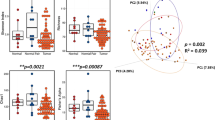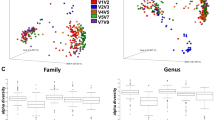Abstract
Purpose
Previous reports suggest that a complex microbiome exists within the female human breast that might contribute to breast cancer etiology. The purpose of this pilot study was to assess the variation in microbiota composition by breast side (left versus right) within individual women and compare the microbiota of normal and breast tumor tissue between women. We aimed to determine whether microbiota composition differs between these groups and whether certain bacterial taxa may be associated with breast tumors.
Methods
Bilateral normal breast tissue samples (n = 36) were collected from ten women who received routine mammoplasty procedures. Archived breast tumor samples (n = 10) were obtained from a biorepository. DNA was extracted, amplified, and sequenced. Microbiota data were analyzed using QIIME and RStudio.
Results
The most abundant phyla in both tumor and normal tissues were Bacteroidetes, Firmicutes, Proteobacteria, and Actinobacteria. There were statistically significant differences in the relative abundance of various bacterial taxa between groups. Alpha diversity (Simpson’s index) was significantly higher in normal compared to tumor samples (0.968 vs. 0.957, p = 0.022). Based on unweighted UniFrac measures, breast tumor samples clustered distinctly from normal samples (R2 = 0.130; p = 0.01). Microbiota composition in normal samples clustered within women (R2 = 0.394; p = 0.01) and by breast side (left or right) within a woman (R2 = 0.189; p = 0.03).
Conclusion
Significant differences in diversity between tumor and normal tissue and in composition between women and between breasts of the same woman were identified. These results warrant further research to investigate the relationship between microbiota and breast cancer.






Similar content being viewed by others
References
Bray F, Ferlay J, Soerjomataram I et al (2018) Global cancer statistics 2018: GLOBOCAN estimates of incidence and mortality worldwide for 36 cancers in 185 countries. CA: Cancer J Clin 68:394–424. https://doi.org/10.3322/caac.21492
Sun Y-S, Zhao Z, Yang Z-N et al (2017) Risk factors and preventions of breast cancer. Int J Biol Sci 13:1387–1397. https://doi.org/10.7150/ijbs.21635
Tao Z, Shi A, Lu C et al (2015) Breast cancer: epidemiology and etiology. Cell Biochem Biophys 72:333–338. https://doi.org/10.1007/s12013-014-0459-6
Sutton T, Reilly P, Johnson N, Garreau JR (2018) Breast cancer in women under 50: most are not high risk. Am J Surg 215:848–851. https://doi.org/10.1016/j.amjsurg.2018.01.003
Ursell LK, Metcalf JL, Parfrey LW, Knight R (2012) Defining the human microbiome. Nutr Rev 70:S38–S44. https://doi.org/10.1111/j.1753-4887.2012.00493.x
Dahmus JD, Kotler DL, Kastenberg DM, Kistler CA (2018) The gut microbiome and colorectal cancer: a review of bacterial pathogenesis. J Gastrointest Oncol 9:769–777. https://doi.org/10.21037/jgo.2018.04.07
Meng C, Bai C, Brown TD et al (2018) Human gut microbiota and gastrointestinal cancer. Genomics Proteomics Bioinformatics 16:33–49. https://doi.org/10.1016/j.gpb.2017.06.002
Tilg H, Cani PD, Mayer EA (2016) Gut microbiome and liver diseases. Gut. https://doi.org/10.1136/gutjnl-2016-312729
Fernández M, Reina-Pérez I, Astorga J et al (2018) Breast cancer and its relationship with the microbiota. Int J Environ Res Public Health 15:1747. https://doi.org/10.3390/ijerph15081747
Shively CA, Register TC, Appt SE et al (2018) Consumption of mediterranean versus western diet leads to distinct mammary gland microbiome populations. Cell Rep 25:47–56.e3. https://doi.org/10.1016/j.celrep.2018.08.078
Hieken TJ, Chen J, Hoskin TL et al (2016) The microbiome of aseptically collected human breast tissue in benign and malignant disease. Sci Rep 6:30751. https://doi.org/10.1038/srep30751
Banerjee S, Tian T, Wei Z et al (2018) Distinct microbial signatures associated with different breast cancer types. Front Microbiol. https://doi.org/10.3389/fmicb.2018.00951
Meng S, Chen B, Yang J et al (2018) Study of microbiomes in aseptically collected samples of human breast tissue using needle biopsy and the potential role of in situ tissue microbiomes for promoting malignancy. Front Oncol. https://doi.org/10.3389/fonc.2018.00318
Thompson KJ, Ingle JN, Tang X et al (2017) A comprehensive analysis of breast cancer microbiota and host gene expression. PLoS ONE 12:e0188873. https://doi.org/10.1371/journal.pone.0188873
Urbaniak C, Cummins J, Brackstone M et al (2014) Microbiota of human breast tissue. Appl Environ Microbiol 80:3007–3014. https://doi.org/10.1128/AEM.00242-14
Urbaniak C, Gloor GB, Brackstone M et al (2016) The microbiota of breast tissue and its association with breast cancer. Appl Environ Microbiol 82:5039–5048. https://doi.org/10.1128/AEM.01235-16
Wang H, Altemus J, Niazi F et al (2017) Breast tissue, oral and urinary microbiomes in breast cancer. Oncotarget 8:88122–88138. https://doi.org/10.18632/oncotarget.21490
Xuan C, Shamonki JM, Chung A et al (2014) Microbial dysbiosis is associated with human breast cancer. PLoS ONE 9:e83744. https://doi.org/10.1371/journal.pone.0083744
Smith A, Pierre JF, Makowski L et al (2019) Distinct microbial communities that differ by race, stage, or breast-tumor subtype in breast tissues of non-Hispanic Black and non-Hispanic White women. Sci Rep 9:1–10. https://doi.org/10.1038/s41598-019-48348-1
Costantini L, Magno S, Albanese D et al (2018) Characterization of human breast tissue microbiota from core needle biopsies through the analysis of multi hypervariable 16S-rRNA gene regions. Sci Rep 8:1–9. https://doi.org/10.1038/s41598-018-35329-z
Caporaso JG, Kuczynski J, Stombaugh J et al (2010) QIIME allows analysis of high-throughput community sequencing data. Nat Methods 7:335–336. https://doi.org/10.1038/nmeth.f.303
Pylro VS, Roesch LFW, Ortega JM et al (2014) Brazilian microbiome project: revealing the unexplored microbial diversity—challenges and prospects. Microb Ecol 67:237–241. https://doi.org/10.1007/s00248-013-0302-4
Edgar RC (2010) Search and clustering orders of magnitude faster than BLAST. Bioinformatics 26:2460–2461. https://doi.org/10.1093/bioinformatics/btq461
Wang Q, Garrity GM, Tiedje JM, Cole JR (2007) Naïve Bayesian classifier for rapid assignment of rRNA sequences into the new bacterial taxonomy. Appl Environ Microbiol 73:5261–5267. https://doi.org/10.1128/AEM.00062-07
DeSantis TZ, Hugenholtz P, Larsen N et al (2006) Greengenes, a chimera-checked 16S rRNA gene database and workbench compatible with ARB. Appl Environ Microbiol 72:5069–5072. https://doi.org/10.1128/AEM.03006-05
Price MN, Dehal PS, Arkin AP (2010) FastTree 2—approximately maximum-likelihood trees for large alignments. PLoS ONE 5:e9490. https://doi.org/10.1371/journal.pone.0009490
McMurdie PJ, Holmes S (2013) phyloseq: An R package for reproducible interactive analysis and graphics of microbiome census data. PLoS ONE 8:e61217. https://doi.org/10.1371/journal.pone.0061217
Love MI, Huber W, Anders S (2014) Moderated estimation of fold change and dispersion for RNA-seq data with DESeq2. Genome Biol. https://doi.org/10.1186/s13059-014-0550-8
Iwai S, Weinmaier T, Schmidt BL et al (2016) Piphillin: improved prediction of metagenomic content by direct inference from human microbiomes. PLoS ONE 11:e0166104. https://doi.org/10.1371/journal.pone.0166104
RStudio Team (2018) RStudio: integrated development for R. RStudio Inc, Boston, MA
Oksanen J, Guillaume FB, Friendly M et al (2019) vegan: Community Ecology Package. R package
Mallick H, McIver LJ, Rahnavard A et al (2020) Multivariable association in population-scale meta-omics studies
Morris EK, Caruso T, Buscot F et al (2014) Choosing and using diversity indices: insights for ecological applications from the German Biodiversity Exploratories. Ecol Evol 4:3514–3524. https://doi.org/10.1002/ece3.1155
Pellegrini S, Sordi V, Bolla AM et al (2017) Duodenal mucosa of patients with type 1 diabetes shows distinctive inflammatory profile and microbiota. J Clin Endocrinol Metab 102:1468–1477. https://doi.org/10.1210/jc.2016-3222
Zhou J, Yao Y, Jiao K et al (2017) Relationship between gingival crevicular fluid microbiota and cytokine profile in periodontal host homeostasis. Front Microbiol. https://doi.org/10.3389/fmicb.2017.02144
Tobias DK, Akinkuolie AO, Chandler PD et al (2018) Markers of inflammation and incident breast cancer risk in the women’s health study. Am J Epidemiol 187:705–716. https://doi.org/10.1093/aje/kwx250
Sanapareddy N, Legge RM, Jovov B et al (2012) Increased rectal microbial richness is associated with the presence of colorectal adenomas in humans. ISME J 6:1858–1868. https://doi.org/10.1038/ismej.2012.43
Chng KR, Chan SH, Ng AHQ et al (2016) Tissue microbiome profiling identifies an enrichment of specific enteric bacteria in Opisthorchis viverrini associated Cholangiocarcinoma. EBioMedicine 8:195–202. https://doi.org/10.1016/j.ebiom.2016.04.034
Yang J, McDowell A, Kim EK et al (2019) Development of a colorectal cancer diagnostic model and dietary risk assessment through gut microbiome analysis. Exp Mol Med 51:1–15. https://doi.org/10.1038/s12276-019-0313-4
Sun T, Liu S, Zhou Y et al (2016) Evolutionary biologic changes of gut microbiota in an ‘adenoma-carcinoma sequence’ mouse colorectal cancer model induced by 1,2-dimethylhydrazine. Oncotarget 8:444–457. https://doi.org/10.18632/oncotarget.13443
Peters BA, Wu J, Pei Z et al (2017) Oral microbiome composition reflects prospective risk for esophageal cancers. Cancer Res 77:6777–6787. https://doi.org/10.1158/0008-5472.CAN-17-1296
Shaw KA, Bertha M, Hofmekler T et al (2016) Dysbiosis, inflammation, and response to treatment: a longitudinal study of pediatric subjects with newly diagnosed inflammatory bowel disease. Genome Med. https://doi.org/10.1186/s13073-016-0331-y
Liu G, Tang CM, Exley RM (2015) Non-pathogenic Neisseria: members of an abundant, multi-habitat, diverse genus. Microbiology 161:1297–1312. https://doi.org/10.1099/mic.0.000086
Iglewski BH (1996) Pseudomonas. In: Baron S (ed) Medical microbiology, 4th ed. University of Texas Medical Branch at Galveston, Galveston (TX)
Cavarretta I, Ferrarese R, Cazzaniga W et al (2017) The microbiome of the prostate tumor microenvironment. Eur Urol 72:625–631. https://doi.org/10.1016/j.eururo.2017.03.029
Wang Y, Xue J, Zhou X et al (2014) Oral microbiota distinguishes acute lymphoblastic leukemia pediatric hosts from healthy populations. PLoS ONE. https://doi.org/10.1371/journal.pone.0102116
Biagi E, Quercia S, Aceti A et al (2017) The bacterial ecosystem of mother’s milk and infant’s mouth and gut. Front Microbiol. https://doi.org/10.3389/fmicb.2017.01214
Ruiz L, Bacigalupe R, García-Carral C et al (2019) Microbiota of human precolostrum and its potential role as a source of bacteria to the infant mouth. Sci Rep 9:1–13. https://doi.org/10.1038/s41598-019-42514-1
Moreno I, Codoñer FM, Vilella F et al (2016) Evidence that the endometrial microbiota has an effect on implantation success or failure. Am J Obstet Gynecol 215:684–703. https://doi.org/10.1016/j.ajog.2016.09.075
McGovern E, Waters SM, Blackshields G, McCabe MS (2018) Evaluating established methods for Rumen 16S rRNA amplicon sequencing with mock microbial populations. Front Microbiol. https://doi.org/10.3389/fmicb.2018.01365
Siegwald L, Touzet H, Lemoine Y et al (2017) Assessment of common and emerging bioinformatics pipelines for targeted metagenomics. PLoS ONE. https://doi.org/10.1371/journal.pone.0169563
Female Breast Cancer Subtypes - Cancer Stat Facts. In: SEER. https://seer.cancer.gov/statfacts/html/breast-subtypes.html. Accessed 8 Oct 2019
Funding
The study was funded by the University of Florida Health Cancer Center and National Science Foundation.
Author information
Authors and Affiliations
Corresponding author
Ethics declarations
Conflict of interest
The authors declare that they have no competing interests.
Ethical approval
This study was reviewed and approved as exempt by the UF Institutional Review Board (IRB) (Protocol Number IRB201600709).
Additional information
Publisher's Note
Springer Nature remains neutral with regard to jurisdictional claims in published maps and institutional affiliations.
Electronic supplementary material
Below is the link to the electronic supplementary material.
Rights and permissions
About this article
Cite this article
Klann, E., Williamson, J.M., Tagliamonte, M.S. et al. Microbiota composition in bilateral healthy breast tissue and breast tumors. Cancer Causes Control 31, 1027–1038 (2020). https://doi.org/10.1007/s10552-020-01338-5
Received:
Accepted:
Published:
Issue Date:
DOI: https://doi.org/10.1007/s10552-020-01338-5




